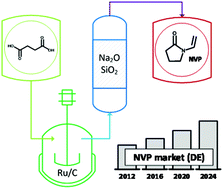Extending the chemical product tree: a novel value chain for the production of N-vinyl-2-pyrrolidones from biogenic acids†
Abstract
The sustainable production of polymers from biogenic platform chemicals shows great promise to reduce the chemical industry's dependence on fossil resources. In this context, we propose a new two-step process leading from dicarboxylic acids, such as succinic and itaconic acid, to N-vinyl-2-pyrrolidone monomers. Firstly, the biogenic acid is reacted with ethanolamine and hydrogen using small amounts of water as solvent together with solid catalysts. For effective conversion, the optimal catalyst (carbon supported ruthenium) has to hold the ability of activating H2 as well as (imide) C![[double bond, length as m-dash]](https://www.rsc.org/images/entities/char_e001.gif) O bonds. The obtained products, N-(2-hydroxyethyl)-2-pyrrolidones, are subsequently converted in a continuous gas phase dehydration over simple sodium-doped silica, with excellent selectivity of above 96 mol% and water as the sole by-product. With a final product yield of ≥72 mol% over two process steps and very little waste due to the use of heterogeneous catalysis, the proposed route appears promising – commercially as well as in terms of Green Chemistry.
O bonds. The obtained products, N-(2-hydroxyethyl)-2-pyrrolidones, are subsequently converted in a continuous gas phase dehydration over simple sodium-doped silica, with excellent selectivity of above 96 mol% and water as the sole by-product. With a final product yield of ≥72 mol% over two process steps and very little waste due to the use of heterogeneous catalysis, the proposed route appears promising – commercially as well as in terms of Green Chemistry.



 Please wait while we load your content...
Please wait while we load your content...